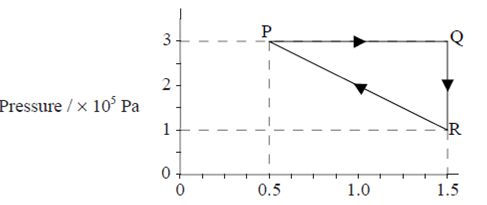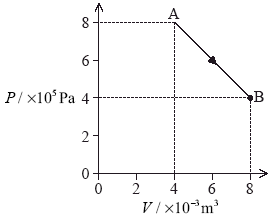
Worksheet 1
1. Which of the following is equivalent to the principle of energy conservation?
A. Newton’s first law
B. The first law of thermodynamics
C. Newton’s second law
D. The second law of thermodynamics
(Total 1 mark)
2. An ideal gas undergoes the
thermodynamic changes represented in the P –V diagram below
(P → Q → R → P).

Volume / m3
Which of the following is the net work done by the gas in a cycle?
A. 4.5 × 105 J
B. 3.0 × 105 J
C. 1.0 × 105 J
D. Zero
(Total 1 mark)
3. This question is about thermodynamics.
The P–V diagram shows the expansion of a fixed mass of an ideal gas, from state A to state B.

The temperature of the gas in state A is 400 K.
(a) Calculate the temperature of the gas in state B.
...............................................................................................................................
...............................................................................................................................
(1)
(b) (i) Calculate the work done by the gas in expanding from state A to state B.
...............................................................................................................................
...............................................................................................................................
...............................................................................................................................
...............................................................................................................................
(2)
(ii) Determine the amount of thermal energy transferred during the expansion from state A to state B.
...............................................................................................................................
...............................................................................................................................
...............................................................................................................................
...............................................................................................................................
(2)
(c) The gas is isothermally compressed from state B back to state A.
(i) Using the P–V diagram axes above, draw the variation of pressure with volume for this isothermal compression.
(1)
(ii) State and explain whether the magnitude of the thermal energy transferred in this case would be less than, equal to or greater than the thermal energy transferred in (b)(ii).
...............................................................................................................................
...............................................................................................................................
...............................................................................................................................
...............................................................................................................................
(2)
(Total 8 marks)
Материалы на данной страницы взяты из открытых источников либо размещены пользователем в соответствии с договором-офертой сайта. Вы можете сообщить о нарушении.